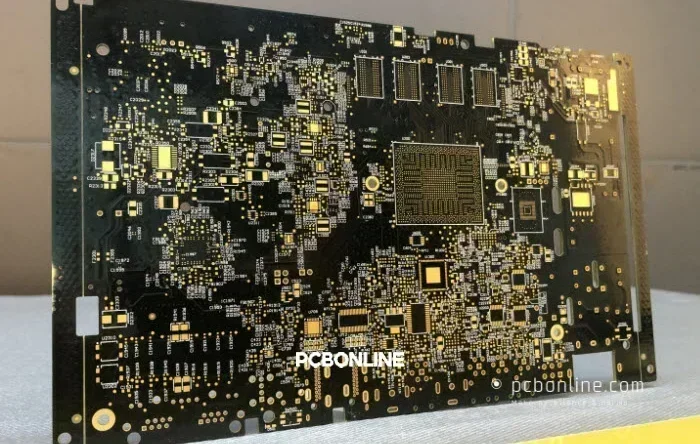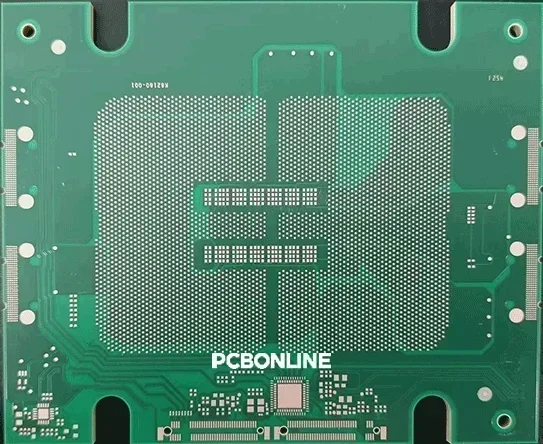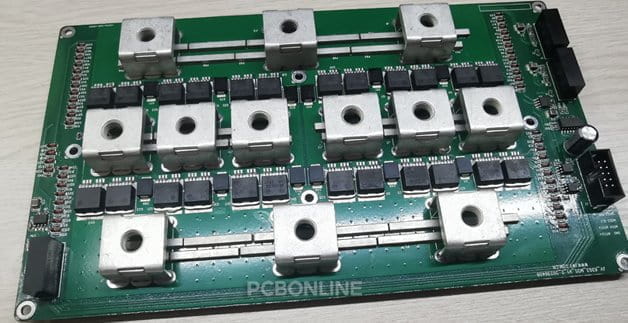When choosing the FR4 material for PCBs (printed circuit boards), its glass transition temperature (Tg) is a critical factor to consider.
This guide by the PCB OEM manufacturer PCBONLINE will explain the meaning of PCB Tg, including choosing a PCB laminate with a proper Tg value for your expected product application.

What is PCB Tg?
PCB Tg (glass transition temperature) means the temperature at which the PCB base material, FR4 epoxy resin, or other materials, changes from a rigid glassy state to a soft rubber-like state.
At temperatures below Tg, the resin is hard, stable, and maintains its mechanical structure. At temperatures above Tg, the resin begins to loosen and expand, causing reduced mechanical strength, increased coefficient of thermal expansion (CTE), stress on copper traces and vias, and even delamination under repeated heating cycles.
For PCBs exposed to high-temperature processes like reflow/wave soldering or harsh operating environments, it is important to select a high-Tg PCB laminate.
Please note that Tg is not the PCB's maximum service temperature. Tg is only the beginning of material softening, about 30°C higher than the PCB's maximum working temperature and 40°C higher than the device failure point.
For long-term reliability, we should select the PCB Tg of at least 25°C above the PCB operating temperature and 35°C above the device operating temperature.
When a PCB uses the FR4 material with Tg above 170°C, we call it a high-Tg PCB. Below, you can find the Tg range of different PCB Tg materials.
|
Material category
|
Tg range
|
PCB Max operating Temp
|
|
Standard FR4
|
130°C – 140°C
|
105°C – 115°C
|
|
Mid-Tg FR4
|
150°C – 165°C
|
120°C – 140°C
|
|
High-Tg FR4
|
170°C – 200°C
|
145°C – 175°C
|
|
High-frequency PTFE
|
250°C – 300°C
|
180°C – 220°C
|
Tg marks the threshold beyond which PCB material properties begin degrading. So PCBs must not continuously operate close to Tg. Otherwise, it accelerates material fatigue and can cause microcracks or barrel cracking inside PCB vias.
High Tg Leads to Better PCB Performances
Tg impacts PCB performance in many respects, including thermal reliability, soldering, mechanical strength, and impedance control. For high-performance PCBs, usually a higher Tg is preferred.
- Thermal reliability: During soldering, reflow peaks can reach 230°C – 260°C, far above normal Tg values. Although PCBs survive these peaks temporarily, a higher Tg means less expansion during reflow, lower risk of pad lifting, better hole wall reliability (via integrity), and better laminate stability.
- Lead-free soldering: High-Tg PCBs are important for lead-free solder processes under higher reflow temperatures around 245°C – 260°C. Low-Tg materials may deform or delaminate during high-temperature lamination processes, wave soldering, and reflow soldering. HDI PCBs with microvias and high-layer-count PCBs all require the FR4 laminate to have a high Tg.
- Mechanical strength: a higher Tg ensures the mechanical strength of the PCB. If a PCB Tg is low, when the operating temperature goes beyond it, the laminate softens and loses structural stability, increasing the chance of bow and twist, layer separation, and warping during reflow.
- Impedance control: High-speed and RF PCBs require stable electrical characteristics. As the temperature approaches Tg, the PCB Dielectric constant (Dk) may shift, the Loss tangent (Df) rises, and impedance becomes less stable. That's why High-frequency materials, such as PTFE, hydrocarbon, and ceramic-filled laminates, have higher Tg and better thermal stability.

Low-Tg, Mid-Tg, and High-Tg FR4
FR4 PCB materials can be grouped by their Tg range, including low-Tg, mid-Tg, and high-Tg.
Standard Low-Tg FR4: < 150°C
A standard FR4 PCB has a Tg of 130°C – 140°C. It is suitable for simple consumer electronics, low-power devices, and two-layer and standard four-layer PCBs. It is not recommended for lead-free soldering unless the PCB uses low-temp solder for PCB assembly.
Mid-Tg FR4: 150°C – 170°C
A mid-Tg FR4 PCB has a Tg of 150°C – 165°C. It is suitable for general lead-free SMT assembly, medium complexity multilayer PCBs, and moderate thermal cycling.
High-Tg FR4: ≥170°C
A high-Tg FR4 PCB has a Tg of 170°C – 200°C. It has the advantages of high thermal stability, excellent reflow performance, better mechanical reliability, and lower CTE. A high-Tg FR4 PCB is used in automotive electronics, industrial equipment, servers, AI hardware, accelerators, power electronics, and LED modules. If your PCB is large, multilayer, or heat-intensive, high-Tg is the better choice.

Select a PCB laminate with a Proper Tg for Product Applications
Selecting the right Tg depends on assembly reflow requirements, PCB complexity, and applications.
If the design requires lead-free reflow (245°C – 260°C) or more than one reflow cycle, use mid-Tg or high-Tg FR4.
If the PCB has 6 or above circuit layers or HDI circuits, use a high-Tg laminate due to more internal heat and stress. For single or 2-layer PCBs, low Tg is OK. Use mid-Tg for 4–6 layers.
Besides assembly and PCB layer requirements, determine a PCB Tg based on the product application. Below are commonly used materials, their Tg values, and suitable applications.
|
PCB material
|
Category
|
Tg
|
Application
|
|
Generic FR4
|
Low-Tg
|
130°C – 140°C
|
Simple consumer electronics
|
|
Shengyi S1000H
|
Low-Tg
|
140°C
|
|
|
Shengyi S1000-2
|
Mid-Tg
|
150°C
|
IoT / general electronics
|
|
NanYa NP-155
|
Mid-Tg
|
150°C – 155°C
|
|
|
Shengyi S1000-2M
|
High-Tg
|
170°C
|
Automotive, Industrial, LED lighting, power electronics, servers, AI accelerators
|
|
Isola 370HR
|
High-Tg
|
180°C
|
|
|
ITEQ IT-180A
|
High-Tg
|
180°C
|
|
|
NanYa NP-175
|
High-Tg
|
175°C
|
|
|
Panasonic Megtron 6
|
High-Tg (high-speed)
|
185°C
|
|
|
Rogers RO4350B
|
High-freq ceramic
|
~280°C
|
RF & microwave, radar, 5G
|
|
Rogers RO4003C
|
High-freq hydrocarbon
|
~280°C
|
|
|
Rogers RO4835
|
High-freq low-loss
|
~280°C
|
|
|
PTFE like Rogers 5880
|
PTFE
|
> 300°C
|
Learn about Other Thermal Parameters of a PCB
PCB Tg is not the only thermal parameter. Td, CTE, T260, T288, and T300 are also important for reliability.
Td (decomposition temperature) is the temperature at which the material decomposes (5% weight loss). It is much higher than PCB Tg. An excellent PCB material has a Td > 330°C.
CTE (coefficient of thermal expansion) measures how much the laminate expands with temperature. When the temperature is below Tg, the CTW is low. When above Tg, there's a rapid expansion of the CTE, which can cause PCB via cracking.
T260, T288, T300 (time to delamination) are times to delaminate at 260°C, 288°C, and 300°C. The higher times that a PCB survives at a set temperature before delamination mean better stability.
Partner with PCBONLINE for OEM High-Tg PCBs
PCBONLINE is an OEM high-Tg PCB manufacturer providing free DFM (design for manufacturing) and one-stop PCBA manufacturing. You can work with PCBONLINE to turn your project into real products with any PCB Tg ranges.

Founded in 2005, PCBONLINE has two large advanced PCB manufacturing bases, one PCB assembly factory, an R&D team, and stable supply chains for components and materials.
PCBONLINE has turnkey PCB manufacturing and assembly capabilities for FR4 PCBs of high Tg up to 210°C and Rogers PCBs of Tg 280°C and above, from PCB prototypes to mass PCB assembly and box-build assembly.
PCBONLINE offers free DFM before and during PCBA prototyping to debug design defects and solve unexpected issues to ensure the success of your PCB, including Gerber, BOM (bill of materials), manufacturing process design, testing, IC burn-in programming, and enclosure.
PCBONLINE has advantages in high-power, high-speed, and high-current PCBs, including industrial controls, AI servers, GPU PCBs, and automotive electronics. We provide engineering support in hardware building and even our development according to your initial idea.
In our PCB laminate warehouse, we have many laminate models in stock ready for immediate PCB fabrication, such as Shengyi S1000-2 with Tg 180°C, Nelco N4000-13/12SI with Tg 210°C, and Rogers RO4350 with Tg 280°C.
When your PCB/PCBA project goes to mass production, PCBONLINE will refund you the fees of R&D, prototyping/sampling, and offer free PCBA functional testing.
High-quality mid and high-end PCB assembly certified with IPC-A-610 Class 3, ISO 9001:2015, ISO 14001:2015, IATF 16949:2016, RoHS, REACH, and UL.
No matter what application of your PCB will be used for, you can let us help your project in engineering and PCB original equipment manufacturing until you receive the PCBA and even final products. To get a quote for your PCB/PCBA, please email info@pcbonline.com. Once you contact us, we will provide you with one-on-one engineering support.
Conclusion
PCB Tg is a temperature range where the PCB substrate transitions from a rigid and glassy state to a soft and rubbery state. When the temperature goes over Tg, it impacts the PCB's mechanical integrity, impedance, and dimensional stability. For reliability, the PCB and the device should work at temperatures of 30+°C and 40+°C lower than PCB Tg. To ensure the success of your high-Tg PCB/PCBA project, get turnkey PCB manufacturing services from the OEM PCB assembly manufacturer PCBONLINE.




